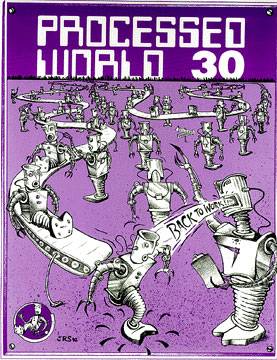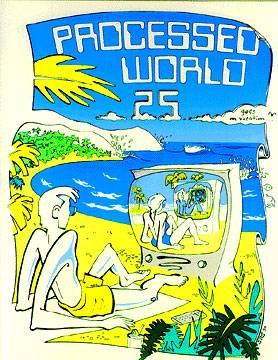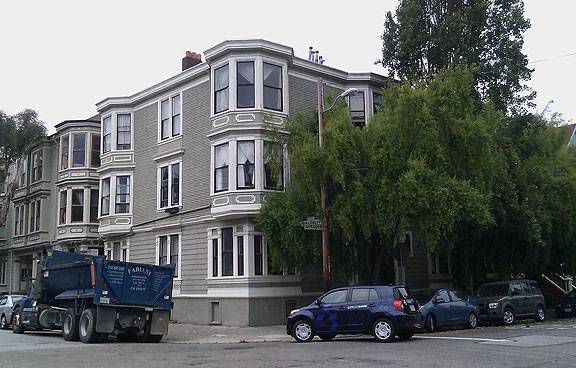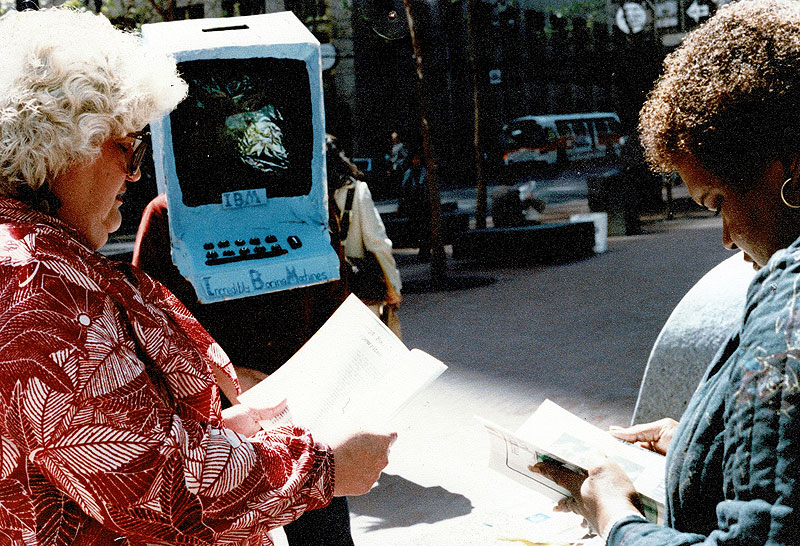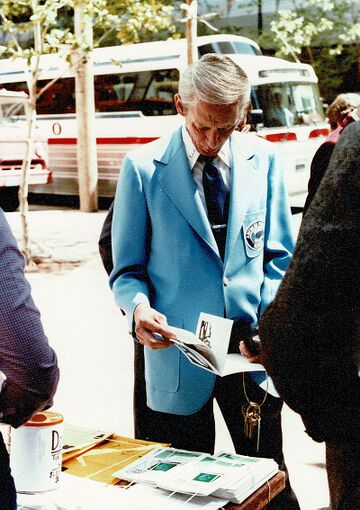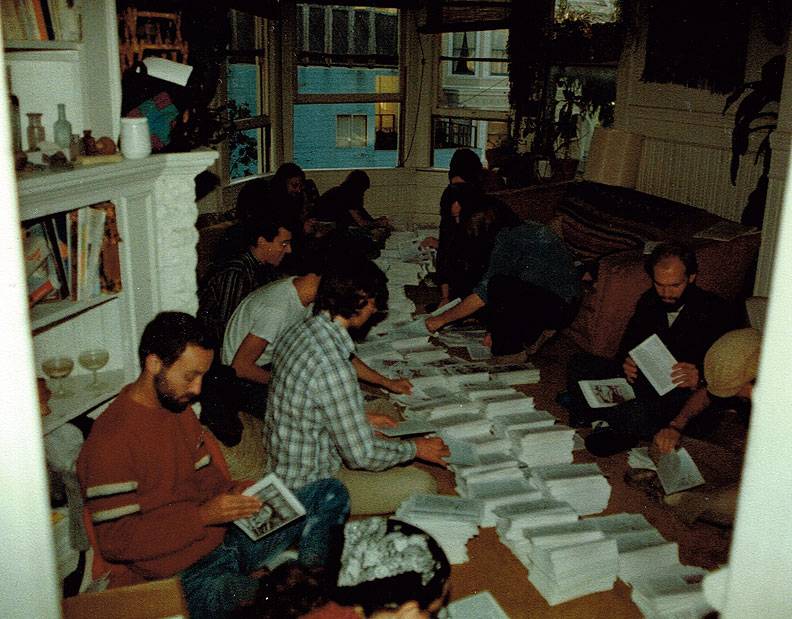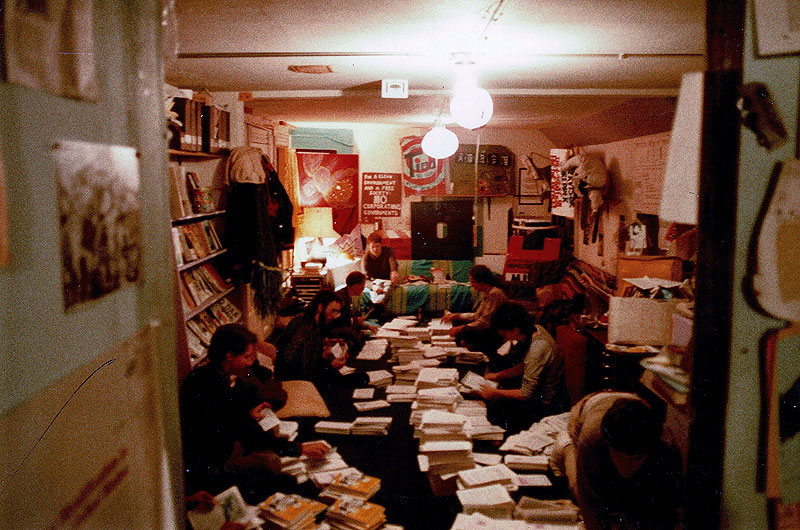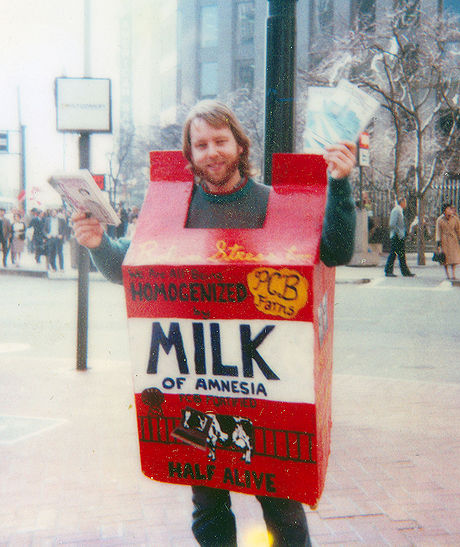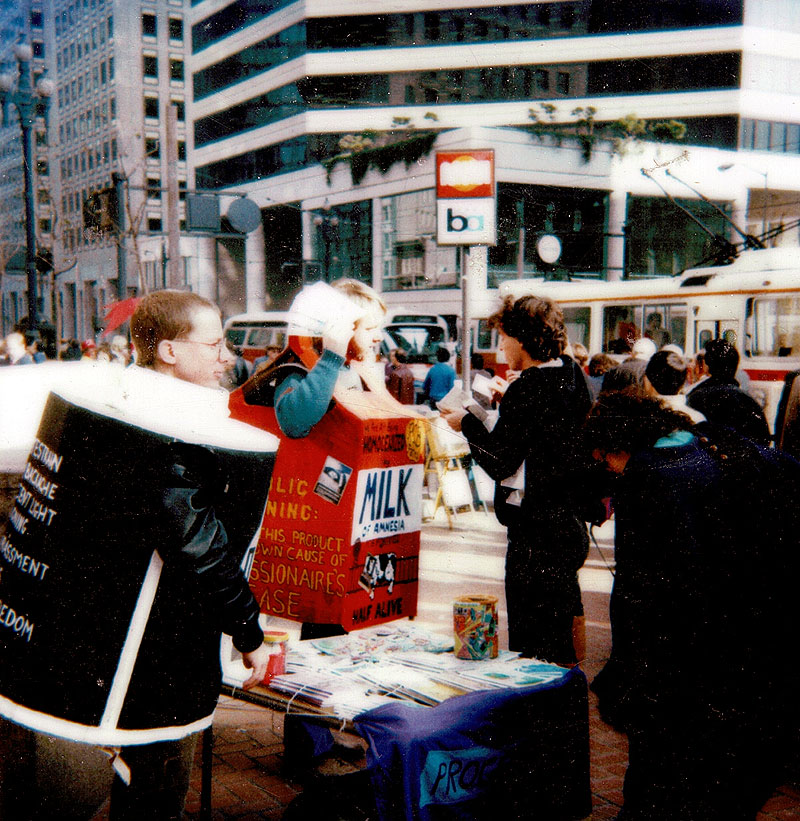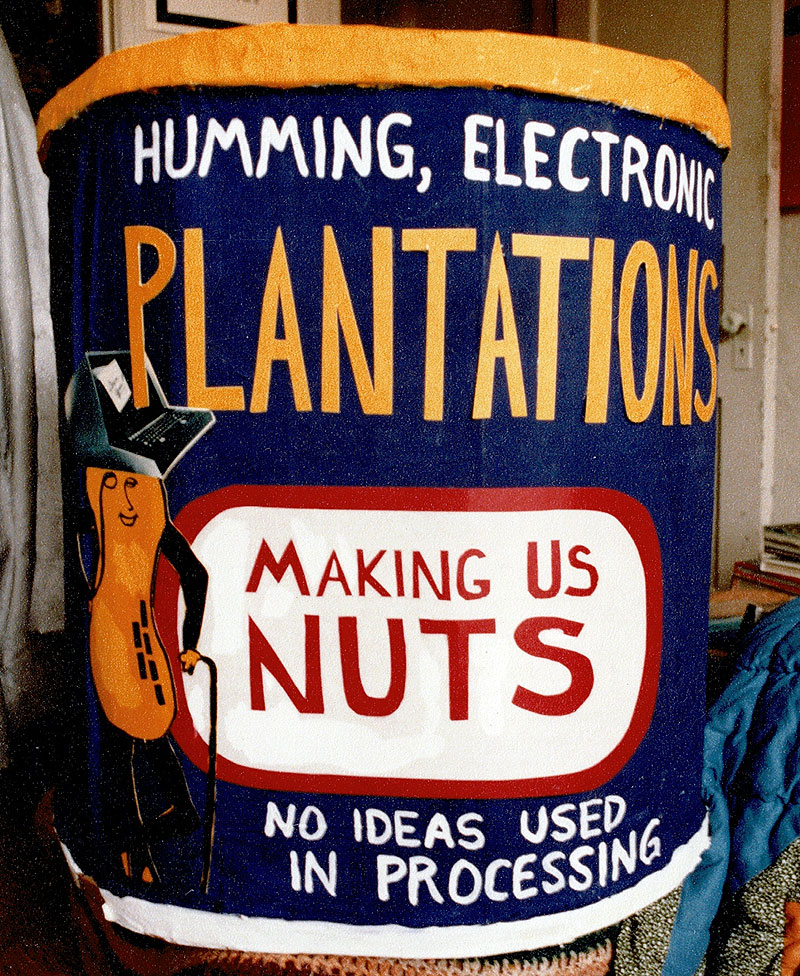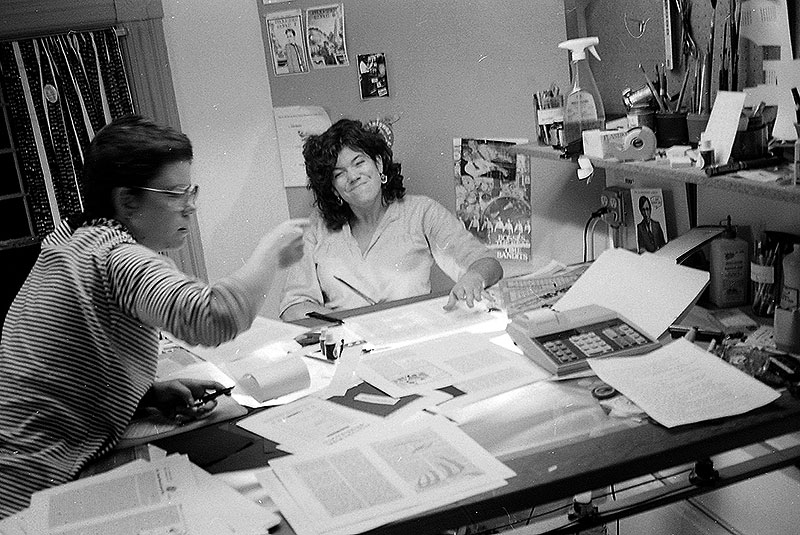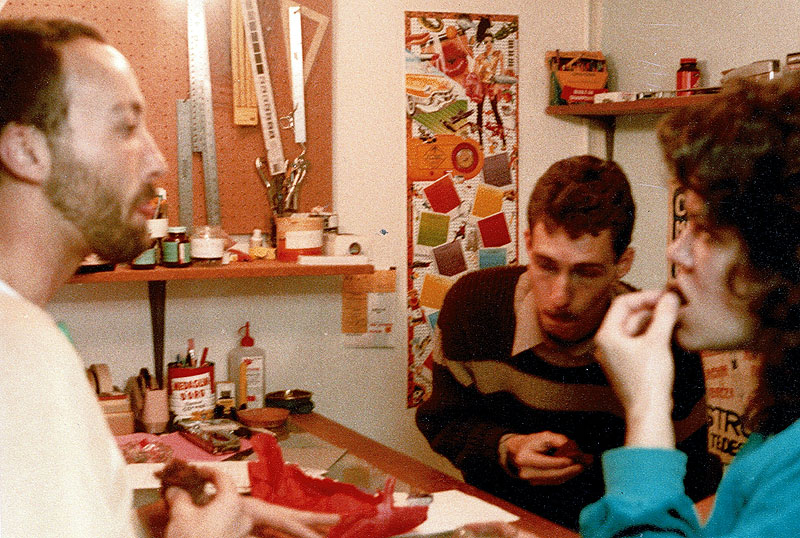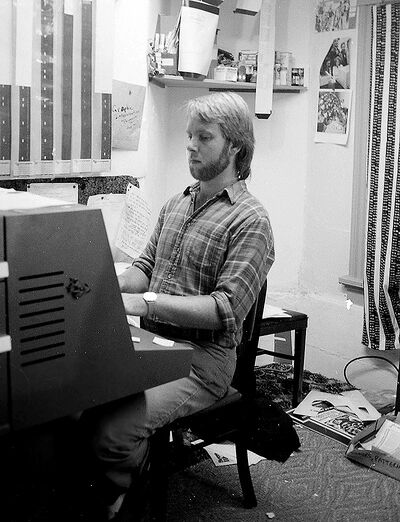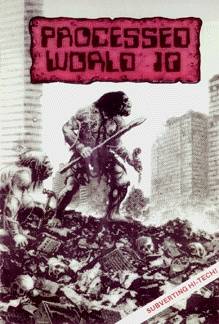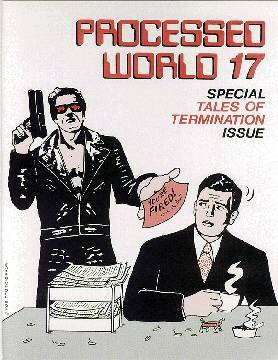Processed World: Difference between revisions
(added photos) |
No edit summary |
||
| Line 41: | Line 41: | ||
Before the founding of ''Processed World'', several participants had already shared in such activities. Chris Carlsson, in fact, first encountered ''PW'' co-founder Caitlin Manning and early collaborator Adam Cornford in a Bay Area agit-prop group called the Union of Concerned Commies. Well before the breakup of that group, the spirit that had animated the UCC was finding a new home. Before ''PW'' was even thought of, Carlsson and partner Caitlin Manning produced a leaflet for National Secretaries Day in April 1980 called "Innervoice #1'' (under the name "Nasty Secretaries Liberation Front"). The leaflet foreshadowed the ''PW'' style. One side was a mock invoice listing the prices paid by an average office worker for her unhappy life. The other was a short analytical essay called "Rebellion Behind The Typewriter." It referred pointedly to the collective power of information handlers to subvert the circulation of capital. | Before the founding of ''Processed World'', several participants had already shared in such activities. Chris Carlsson, in fact, first encountered ''PW'' co-founder Caitlin Manning and early collaborator Adam Cornford in a Bay Area agit-prop group called the Union of Concerned Commies. Well before the breakup of that group, the spirit that had animated the UCC was finding a new home. Before ''PW'' was even thought of, Carlsson and partner Caitlin Manning produced a leaflet for National Secretaries Day in April 1980 called "Innervoice #1'' (under the name "Nasty Secretaries Liberation Front"). The leaflet foreshadowed the ''PW'' style. One side was a mock invoice listing the prices paid by an average office worker for her unhappy life. The other was a short analytical essay called "Rebellion Behind The Typewriter." It referred pointedly to the collective power of information handlers to subvert the circulation of capital. | ||
[[Image: | [[Image:PW1-selling-on-Market-Street-w-IBM-head-April-1981.jpg]] | ||
'''Hawking Processed World to office workers on Montgomery and Market in 1981.''' | '''Hawking Processed World to office workers on Montgomery and Market in 1981.''' | ||
[[Image:Security-guy-reading-PW-1-at-Market-and-Montgomery-Crocker-Plaza-April-1981.jpg|360px|right]] | |||
'''Crocker security guy perusing magazines in April 1981.''' | |||
''Photo: Chris Carlsson'' | |||
A year later, in April 1981, the first ''Processed World'' hit the streets, Carlsson and Manning having been joined by ex-UCCers Adam Cornford and Christopher Winks (and Steve Stallone as pre-press consultant and printer) in producing that first issue. Finding themselves amid the bulging supply rooms of the modern office, ''Processed World's'' friends began collecting resources for the magazine; the first two issues were printed on paper unknowingly "donated" by San Francisco's major banks. A short while later, Gidget Digit and a half dozen others, mostly already friends of the founders, joined the newborn project. The cover art for ''PW'' 2 was drawn by a woman who, with her co-worker, wrote in the first wildly enthusiastic letter received by the magazine, and helped realize ''PW's'' role as forum. Another new contact, Bonita Thoreson, frustrated with her efforts to write for the proto-union "Working Women" newspaper ''Downtown Women's News'', became an avid participant when she discovered ''PW'''s hawkers on a busy downtown street while she was temping. Other participants came in the same way. | A year later, in April 1981, the first ''Processed World'' hit the streets, Carlsson and Manning having been joined by ex-UCCers Adam Cornford and Christopher Winks (and Steve Stallone as pre-press consultant and printer) in producing that first issue. Finding themselves amid the bulging supply rooms of the modern office, ''Processed World's'' friends began collecting resources for the magazine; the first two issues were printed on paper unknowingly "donated" by San Francisco's major banks. A short while later, Gidget Digit and a half dozen others, mostly already friends of the founders, joined the newborn project. The cover art for ''PW'' 2 was drawn by a woman who, with her co-worker, wrote in the first wildly enthusiastic letter received by the magazine, and helped realize ''PW's'' role as forum. Another new contact, Bonita Thoreson, frustrated with her efforts to write for the proto-union "Working Women" newspaper ''Downtown Women's News'', became an avid participant when she discovered ''PW'''s hawkers on a busy downtown street while she was temping. Other participants came in the same way. | ||
| Line 54: | Line 60: | ||
'''Collating Processed World #4 at 759 Shrader in 1982.''' | '''Collating Processed World #4 at 759 Shrader in 1982.''' | ||
[[Image:PW-12-collating-party-1984.jpg]] | |||
'''Collating Processed World #12 at 460 Ashbury in 1984.''' | |||
''Processed World'' always depended on collating parties, a modern-day urban version of the barn-raising. A week or two prior to the finish of printing, a leaflet would go out to the entire Bay Area mailing list, inviting people to come and help collate the forthcoming issue. Many people, isolated at their jobs, would delight in coming to the collating party as their main opportunity to contribute more than money to the PW effort, and as their chance to attend a kind of radical intellectual salon. From noon to as late as midnight, 50-100 people would pass through and take a shift sitting before a tall pile of pages. Amid clouds of marijuana smoke, bottles of beer, and a rich potluck buffet, each person slowly passed the folded pages along, adding their two or three, until collated copies were boxed at the end of the line, ready for the bindery. (Cut-rate binding was provided by a bindery in Oakland, where owner Joe P. took a liking to the project and was always very helpful.) Collating parties lasted through issue 18; by then, every joke and humorous aside about assembly lines and free labor had been thoroughly exhausted. ''PW'' finally went "upscale" and started paying to be printed and bound by a web-press company. | ''Processed World'' always depended on collating parties, a modern-day urban version of the barn-raising. A week or two prior to the finish of printing, a leaflet would go out to the entire Bay Area mailing list, inviting people to come and help collate the forthcoming issue. Many people, isolated at their jobs, would delight in coming to the collating party as their main opportunity to contribute more than money to the PW effort, and as their chance to attend a kind of radical intellectual salon. From noon to as late as midnight, 50-100 people would pass through and take a shift sitting before a tall pile of pages. Amid clouds of marijuana smoke, bottles of beer, and a rich potluck buffet, each person slowly passed the folded pages along, adding their two or three, until collated copies were boxed at the end of the line, ready for the bindery. (Cut-rate binding was provided by a bindery in Oakland, where owner Joe P. took a liking to the project and was always very helpful.) Collating parties lasted through issue 18; by then, every joke and humorous aside about assembly lines and free labor had been thoroughly exhausted. ''PW'' finally went "upscale" and started paying to be printed and bound by a web-press company. | ||
| Line 61: | Line 71: | ||
'''Chris Carlsson distributing Processed World #7s, #8s, and #9s in 1983.''' | '''Chris Carlsson distributing Processed World #7s, #8s, and #9s in 1983.''' | ||
''Photo: Susan | ''Photo: Susan Gibbons'' | ||
[[Image:Mark-Leger-and-Crhsi-Carlsson-at-Montgomery-and-Market-c-1984.jpg]] | |||
'''Mark Leger in Whiteout Can and Chris Carlsson in Milk of Amnesia box at Montgomery and Market, 1984.''' | |||
''Photo: Susan Gibbons'' | |||
On Saturday, April 14, 1984, ''Processed World'' organized a tour of Silicon Valley, hosted by Dennis Hayes, PW's then newfound SilVal writer. Piling into an old blue bus, some twenty-five malcontents proceeded on a performance/happening to visit a the fabled Valley, by way of the Airforce's Blue Cube satellite control center, the Rolm Corporation's campus-like offices, and Benny Bufano's giant missile-like Madonna, and the squeaky-clean Fashion Island shopping mall. The tour got plenty of attention from nervous security guards and even received a weird write-up in ''Infosystems'' magazine, continuing ''PW'''s already considerable media coverage. | On Saturday, April 14, 1984, ''Processed World'' organized a tour of Silicon Valley, hosted by Dennis Hayes, PW's then newfound SilVal writer. Piling into an old blue bus, some twenty-five malcontents proceeded on a performance/happening to visit a the fabled Valley, by way of the Airforce's Blue Cube satellite control center, the Rolm Corporation's campus-like offices, and Benny Bufano's giant missile-like Madonna, and the squeaky-clean Fashion Island shopping mall. The tour got plenty of attention from nervous security guards and even received a weird write-up in ''Infosystems'' magazine, continuing ''PW'''s already considerable media coverage. | ||
| Line 70: | Line 86: | ||
''Photo: Laura Fraser'' | ''Photo: Laura Fraser'' | ||
[[Image:Plantations-Can-front-c-1984.jpg]] | |||
'''The Plantations Can built on well-known San Francisco-based Planter's Peanut brand.''' | |||
''Photo: Chris Carlsson'' | |||
Just a month later, [[APOCAPOLITICS IN PRACTICE: THE END OF THE WORLD'S FAIR| The End Of The World's Fair]], a radical cultural festival aimed at providing alternatives to the New Age pieties of the mainstream peace and ecology movements, was held in S.F.'s Dolores Park. The organizing for the event was done out of the PW offices (primarily by Gary Roush), though the committee behind the Fair was separate from the PW collective. The ''Processed World'' collective created a float called "Terminals With Ears" and, with its many props, made a memorable appearance in the Fair's costume show. Annual picnics at various Bay Area parks provided another place for people to meet. | Just a month later, [[APOCAPOLITICS IN PRACTICE: THE END OF THE WORLD'S FAIR| The End Of The World's Fair]], a radical cultural festival aimed at providing alternatives to the New Age pieties of the mainstream peace and ecology movements, was held in S.F.'s Dolores Park. The organizing for the event was done out of the PW offices (primarily by Gary Roush), though the committee behind the Fair was separate from the PW collective. The ''Processed World'' collective created a float called "Terminals With Ears" and, with its many props, made a memorable appearance in the Fair's costume show. Annual picnics at various Bay Area parks provided another place for people to meet. | ||
| Line 78: | Line 100: | ||
''Photo: Glenn Bachmann'' | ''Photo: Glenn Bachmann'' | ||
[[Image:Will-Roscoe-and-Brad-Rose-and-Caitlin-Manning-at-layout-table-in-460-Ashbury-c-1984.jpg]] | |||
'''Will Roscoe, Brad Rose, and Caitlin Manning at layout table in 460 Ashbury, c. 1984.''' | |||
''Photo: Chris Carlsson'' | |||
[[Image:Cc-at-typesetting-machine-at-460-Ashbury-c-1984 010.jpg|400px|left]] | [[Image:Cc-at-typesetting-machine-at-460-Ashbury-c-1984 010.jpg|400px|left]] | ||
Latest revision as of 00:02, 2 January 2024
"I was there..."
by Chris Carlsson and Adam Cornford
<iframe src="https://archive.org/embed/ssfPWSTRT" width="640" height="480" frameborder="0" webkitallowfullscreen="true" mozallowfullscreen="true" allowfullscreen></iframe>
Selling Processed Worlds on Market and Montgomery Streets, San Francisco, 1982.
Super 8 film shot by Susan Cleveland
PW 30, the self-replicating assemblyline
Art by Jim Swanson
PW 25, the recursive vacation!
Art by Jim Swanson
<iframe src="https://archive.org/embed/ProcessedWorldRadioMagazineExcerpt" width="411" height="30" frameborder="0" webkitallowfullscreen="true" mozallowfullscreen="true" allowfullscreen></iframe>
Processed World Radio magazine: a short excerpt from a longer piece available here.
Processed World magazine was founded in 1981 by a small group of dissidents, mostly in their twenties, who were then working in San Francisco's financial district. The magazine's creators found themselves using their only marketable skill after years of university education: "handling information." In spite of being employed in offices as "temps," few really thought of themselves as "office workers." More common was the hopeful assertion that they were photographers, writers, artists, dancers, historians or philosophers.
In the 2nd floor apartment of this building (759 Shrader at Beulah in the Haight Ashbury) Processed World was started in 1981.
Photo: Chris Carlsson
Beyond these creative ambitions, the choice to work "temp" was also a refusal to join the rush toward business/yuppie professionalism. Instead of 40-70 hour weeks at thankless corporate career climbing, they sought more free time to pursue their creative instincts. Nevertheless, day after day, they found themselves cramming into public transit en route to the ever-expanding Abusement Park of the financial district. Thus, from the start, the project's expressed purpose was twofold: to serve as a contact point and forum for malcontent office workers (and wage-workers in general) and to provide a creative outlet for people whose talents were blocked by what they were doing for money.
The idea for a new magazine struck one of these people, Chris Carlsson, while he was on vacation in the summer of 1980. The sources of this brainstorm were simultaneously a certain socio-economic layer of late twentieth century U.S. society, a group of friends, and certain obscure artistic and political tendencies comprising both post-New Left, post-situationist libertarian radicalism and the dissident cultural movement whose most public expression was punk and new wave music.
In the late seventies a number of radicals around San Francisco and New York who had ridden out the decline of the social opposition with brains unscrambled, principles more or less intact and rage intensified, found themselves drawn to the punk/new wave milieu. Incoherent and often crude as it was, it looked like the only game in town -- the only place where fundamentals of the ruling ideology like Work, Family, Country, Obedience, and Niceness were being challenged with real panache and real venom. Some of these people formed bands while others organized shows. And still others worked in graphic media such as posters, fanzines and comic books, or revived street theater and other kinds of political performance. Between these people, numbering at most a few thousand around the country, images, ideas, jokes, slogans and techniques circulated like amphetamines in the cultural bloodstream.
Before the founding of Processed World, several participants had already shared in such activities. Chris Carlsson, in fact, first encountered PW co-founder Caitlin Manning and early collaborator Adam Cornford in a Bay Area agit-prop group called the Union of Concerned Commies. Well before the breakup of that group, the spirit that had animated the UCC was finding a new home. Before PW was even thought of, Carlsson and partner Caitlin Manning produced a leaflet for National Secretaries Day in April 1980 called "Innervoice #1 (under the name "Nasty Secretaries Liberation Front"). The leaflet foreshadowed the PW style. One side was a mock invoice listing the prices paid by an average office worker for her unhappy life. The other was a short analytical essay called "Rebellion Behind The Typewriter." It referred pointedly to the collective power of information handlers to subvert the circulation of capital.
Hawking Processed World to office workers on Montgomery and Market in 1981.
Crocker security guy perusing magazines in April 1981.
Photo: Chris Carlsson
A year later, in April 1981, the first Processed World hit the streets, Carlsson and Manning having been joined by ex-UCCers Adam Cornford and Christopher Winks (and Steve Stallone as pre-press consultant and printer) in producing that first issue. Finding themselves amid the bulging supply rooms of the modern office, Processed World's friends began collecting resources for the magazine; the first two issues were printed on paper unknowingly "donated" by San Francisco's major banks. A short while later, Gidget Digit and a half dozen others, mostly already friends of the founders, joined the newborn project. The cover art for PW 2 was drawn by a woman who, with her co-worker, wrote in the first wildly enthusiastic letter received by the magazine, and helped realize PW's role as forum. Another new contact, Bonita Thoreson, frustrated with her efforts to write for the proto-union "Working Women" newspaper Downtown Women's News, became an avid participant when she discovered PW's hawkers on a busy downtown street while she was temping. Other participants came in the same way.
Processed World's founders saw the importance of community "without horizontal links between people in similar predicaments, no amount of rhetoric, agitation, or sabotage would begin to change conditions." Every Friday writers and editors would head out to the streets to hawk magazines, asking a dollar donation rather than "selling" so as to avoid restrictions on street merchants and to remain protected by the First Amendment's freedom of speech provisions. Collective members would don papier-mache costumes. These, like VDT heads-masks labelled "IBM -- Intensely Boring Machines" and "Data Slave," or an enormous detergent box whose familiar red-and-yellow sides read "Bound, Gagged, & TIED to useless work, day in, day out, for the rest of your life?" attracted immediate if often puzzled attention from passersby. Sellers pranced around on busy financial district streets, while yelling "Processed World: The Magazine With A Bad Attitude!" or "Are You Doing the Processing, or Being Processed?" or "If You Hate Your Job Then You'll Love This Magazine!" (In fact, many of PW's slogans evolved as such street cries, spontaneously composed on the spot.) In this way, PW managed to develop and maintain a fairly close rapport with its office workforce constituency. Many fascinating dialogues took place during these Friday lunch hour soirees, and a feedback loop was established whereby readers, writers and editors would discuss articles in person, right on the street.
More formal social events were developed in pursuit of a new dissident community. Bi-weekly gatherings at Spec's bar in North Beach began in February 1982; these grew to attract upwards of 40 people every other Wednesday night, until they died out two and a half years later, in late 1984.
Collating Processed World #4 at 759 Shrader in 1982.
Collating Processed World #12 at 460 Ashbury in 1984.
Processed World always depended on collating parties, a modern-day urban version of the barn-raising. A week or two prior to the finish of printing, a leaflet would go out to the entire Bay Area mailing list, inviting people to come and help collate the forthcoming issue. Many people, isolated at their jobs, would delight in coming to the collating party as their main opportunity to contribute more than money to the PW effort, and as their chance to attend a kind of radical intellectual salon. From noon to as late as midnight, 50-100 people would pass through and take a shift sitting before a tall pile of pages. Amid clouds of marijuana smoke, bottles of beer, and a rich potluck buffet, each person slowly passed the folded pages along, adding their two or three, until collated copies were boxed at the end of the line, ready for the bindery. (Cut-rate binding was provided by a bindery in Oakland, where owner Joe P. took a liking to the project and was always very helpful.) Collating parties lasted through issue 18; by then, every joke and humorous aside about assembly lines and free labor had been thoroughly exhausted. PW finally went "upscale" and started paying to be printed and bound by a web-press company.
Chris Carlsson distributing Processed World #7s, #8s, and #9s in 1983.
Photo: Susan Gibbons
Mark Leger in Whiteout Can and Chris Carlsson in Milk of Amnesia box at Montgomery and Market, 1984.
Photo: Susan Gibbons
On Saturday, April 14, 1984, Processed World organized a tour of Silicon Valley, hosted by Dennis Hayes, PW's then newfound SilVal writer. Piling into an old blue bus, some twenty-five malcontents proceeded on a performance/happening to visit a the fabled Valley, by way of the Airforce's Blue Cube satellite control center, the Rolm Corporation's campus-like offices, and Benny Bufano's giant missile-like Madonna, and the squeaky-clean Fashion Island shopping mall. The tour got plenty of attention from nervous security guards and even received a weird write-up in Infosystems magazine, continuing PW's already considerable media coverage.
PWers pause on a corporate patio during a frantic and hilarious 1984 tour of Silicon Valley.
Photo: Laura Fraser
The Plantations Can built on well-known San Francisco-based Planter's Peanut brand.
Photo: Chris Carlsson
Just a month later, The End Of The World's Fair, a radical cultural festival aimed at providing alternatives to the New Age pieties of the mainstream peace and ecology movements, was held in S.F.'s Dolores Park. The organizing for the event was done out of the PW offices (primarily by Gary Roush), though the committee behind the Fair was separate from the PW collective. The Processed World collective created a float called "Terminals With Ears" and, with its many props, made a memorable appearance in the Fair's costume show. Annual picnics at various Bay Area parks provided another place for people to meet.
Bonita Thoreson (Helen Highwater) and Caitlin Manning (Maxine Holz) laying out graphics at the basement office of Processed World at 460 Ashbury, late 1983.
Photo: Glenn Bachmann
Will Roscoe, Brad Rose, and Caitlin Manning at layout table in 460 Ashbury, c. 1984.
Photo: Chris Carlsson
Chris Carlsson working at the Compugraphic Jr. typesetting machine in the Processed World office at 460 Ashbury Street, 1984.
Photo: Glenn Bachmann
While a community did appear, at least in fits and starts, it did not last. PW never had a specific goal in creating the community, beyond hoping for a movement to erupt independently of the magazine. Many people came to the magazine and its gatherings looking for "answers," for some kind of organizational structure or at least for an idea about what to do the next day at work. But while ideas were plentiful, PW always lacked a coherent "program." It had no clear-cut plan of action in which to incorporate people, let alone an actual organizational presence in offices. Those who came looking for such things went away disappointed.
Not that the organizing-oriented and programmatic groups had a great deal more success. Attempts to organize office workers by traditional bureaucratic service-worker unions like the SEIU and OPEIU were largely a flop. Indeed these unions, like most others during the early eighties, actually lost a lot of members to decertification elections and runaway shops, which began to afflict the clerical workforce much as they had been battering industrial and transportation workers for several years already. More promising efforts, like the underground independent proto-unions Bankworkers United and IBM Workers United, with which PW had contacts in its first four years, fizzled out in the heavy rain of repression under Reagan. As the '80s progressed, and people became more atomized than they were even at the start of the decade, expectations of a political movement based on office workers evaporated. In fact, many PW participants (who have numbered in the hundreds over the course of its life) did not remain in offices either. Lacking a larger oppositional movement among office workers or even a clear-cut strategy for creating one, most early PWers took the classic American Way Out: they found other ways to make a living, some as computer programmers or technical writers, several as teachers, still others as graphic and production artists, although a number continue to process words as temps in offices.
As its producers migrated out of supervised office work, the magazine began addressing a broader range of subjects, albeit without losing contact with its roots. Children (14), Food (15), and Medicine (20) are just three of the special issues which went considerably beyond the office while preserving a focus on work and its discontents. By issue 15 (winter '85-6) the collective revised its sense of purpose:
[From the Talking Heads introduction to PW 15]: ...The magazine has gone in a different direction than the one its founders intended. PW was to be a meeting point for dissatisfied and rebellious workers in the "new" technical and service sectors, a place where they could vent their frustrations and share their dreams. So far, so good. But we wanted to go beyond frustration-venting and dream-sharing to help develop strategies for organized resistance at work. We wanted the rebellion to become practical.
In 1980-81, this didn't look so farfetched. Revolt was in the air... But as the Right got a firmer grip on the mass media and as the recession hit, terrorizing millions of workers into submission, the revolt largely faded away. Today, an atmosphere of anxious subservience, thinly veiled in born-again patriotism and consumption-mania, pervades daily life.
With office work in particular, the problem goes even deeper. PW has always distinguished its "take" on workplace organizing from more traditional approaches by pointing out that most work in the modern office is at best useless in terms of real human needs, and at worst (as with real-estate, banking, and nuclear and military contracting) actively destructive. Rebel office workers, sensing this, don't identify with their work. They generally change jobs often and work as little as possible. Their revolt takes the form of on-the-job disorganizing -- absenteeism, disinformation, sabotage. They seldom view as worthwhile either the risk or the effort involved in creating a workers' self-defense organization. Moreover, rightly or wrongly, they believe that most workers, who identify more with their jobs, also identify with management. As a result, the rebels tend to be as alienated from their co-workers as they are from the boss. Perhaps this is why PW's extensive discussions of autonomous office-worker organizing seem to fall largely on deaf ears -- while its frequent references to sabotage have made it notorious...
...Any real mass upsurge seems far away. In that case, isn't PW in danger of marketing the image of a non-existent revolt to be passively consumed by its reader-contributors? Perhaps. But we think that even in the absence of real revolt, PW is helping to create the cultural preconditions for it. Again and again, readers tell us: "I thought I was the only person who felt this way. Now I know I'm not alone." One of PW's principal aims is to make people feel good about hating their jobs, not to mention despising the dullness and ugliness of so much of life in general...
" free solidarity against authoritarian fake community, nameless wildness against well-organized death. This helps us to survive a bleak time. We hope it does the same for you. Together, perhaps, we can achieve a lot more. Write us."
Processed World No.10
Art by Paul Mavrides
Processed World No. 17
Art by Tom Tomorrow

